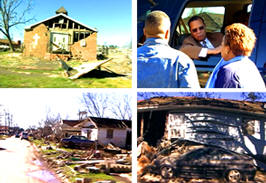FCNNEWSSOURCE
After Katrina: A Tour of New Orleans 9th Ward (FCN Webcast, 01/2006)

(FinalCall.com) – In its continuing coverage in documenting the aftermath of hurricane Katrina, FinalCall.com News is providing an exclusive tour of the New Orleans Lower 9th Ward showing conditions over 6 months after hurricane Katrina and multiple promises of aid.
The Lower 9th Ward is a section of the city of New Orleans, Louisiana. As the name implies, it is part of the Ninth Ward of New Orleans. The term “Lower” refers to its location further towards the mouth of the Mississippi River, “down” or “below” the rest of the city in local geographic terminology. The area is sometimes just referred to as the “Lower 9”.
The population is mostly Black, with the majority of the non-Black minority in the section of the neighborhood closer to the river. Although mostly working class, about 60% of the homes in the Lower Ninth Ward were owner occupied.
Originally a cypress swamp, the area was the lower portion of plantations that stretched from the river to the lake. Poor Black people and immigrant laborers from Ireland, Germany and Italy desperate for homes but unable to afford housing in other areas of the city risked flooding and disease to move here. In the 1870s, several African American benevolent associations and mutual-aid societies organized to assist scores of struggling freedmen (formerly-enslaved Black people) in the area.
What became the Lower 9th Ward did not become distinct from the parts of the 9th Ward just upriver until the Industrial Canal was dredged at the start of the 1920s, bisecting the 9th Ward. At this time, people started referring to the area “above” (up river) from the Canal as the “Upper” 9th Ward, and this area as the “Lower”.
Due to the Ninth Ward’s geographic separation and working-class inhabitants, residents have developed a history of activism encouraged by seeming neglect by city officials. Civic groups established in the neighborhood have historically fought diligently to obtain funds and services for the Lower Ninth Ward.
As a result of the activism of residents (particularly from the Lower Ninth Ward) that emerged with the fight for civil rights, and the expertise of the NAACP legal team, the school desegregation movement marked New Orleans as the first deep-South school district to open its all-white doors to black children.
One of those first schools was McDonogh #19, now called Louis D. Armstrong Elementary, on St. Claude Avenue. This 1960 historical event spurred violent white protest and attracted media attention from around the world. After the crisis subsided, white Lower Ninth Warders began a decade-long exodus eastward into St. Bernard Parish.
As of January 2006, the great devastation and difficulties in restoring basic utilities and city services have made the Lower 9th Ward the last portion of the city of New Orleans not yet officially reopened to residents who wish to return to live, and the only area of the city still under a curfew. Officially residents are allowed in during daylight hours to look, salvage possessions, and leave, although some few have already done extensive work gutting and repairing their damaged homes in preparation to move back.
A Bring Back New Orleans Commission preliminary report suggested making the lower elevation portion of the neighborhood in back of Claiborne in whole or part into park space. The suggestion is vehemently objected to by most Lower 9th Ward residents.
Sources:
* http://en.wikipedia.org/wiki/Lower_Ninth_Ward
* http://www.gnocdc.org/orleans/8/22/snapshot.html












